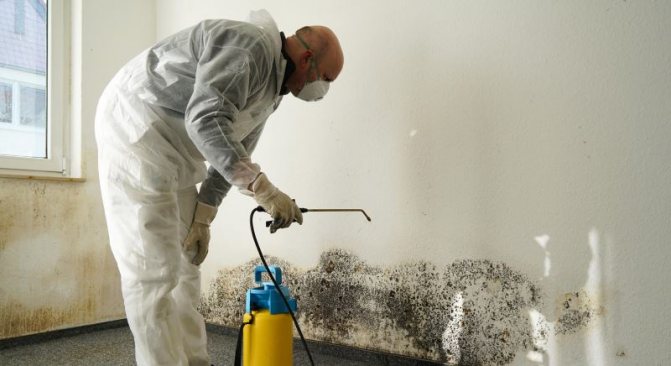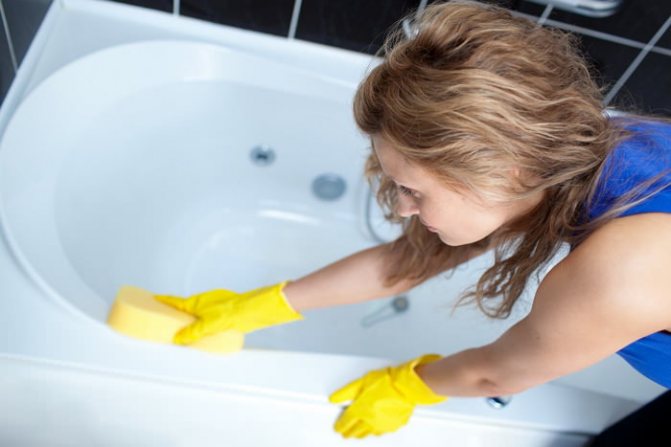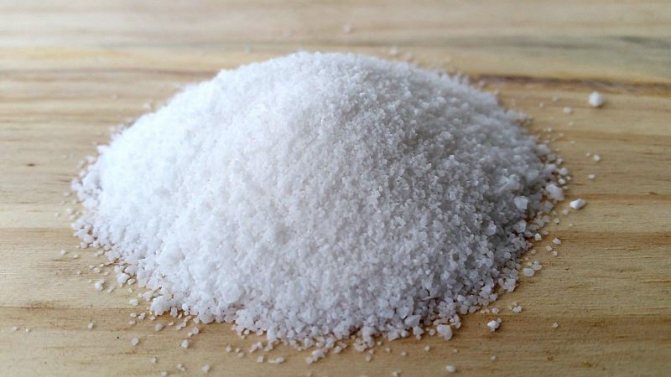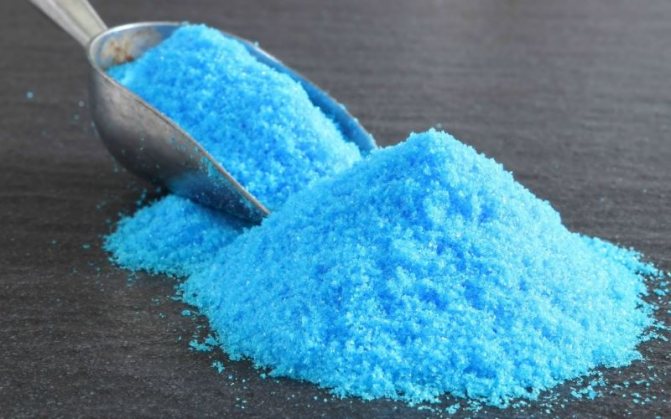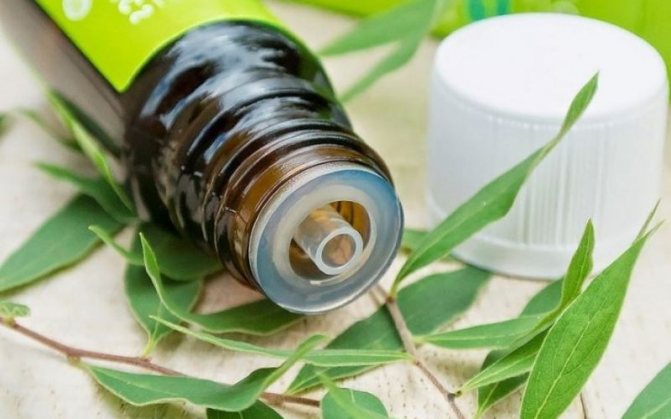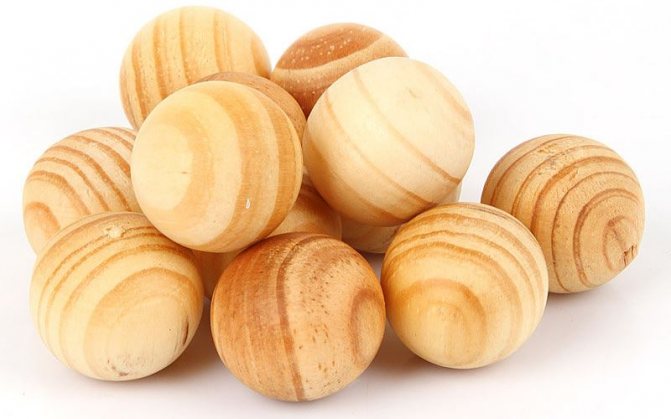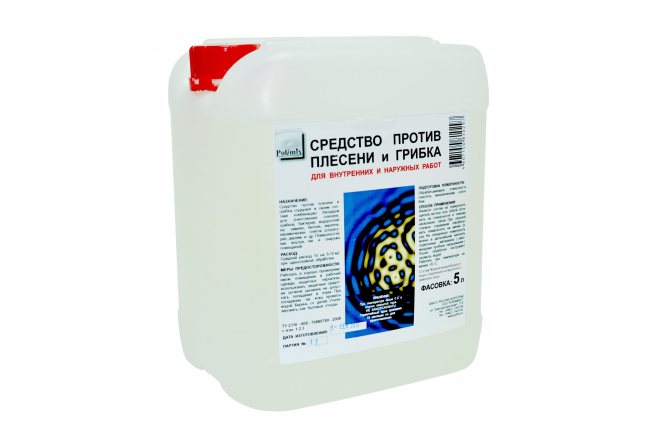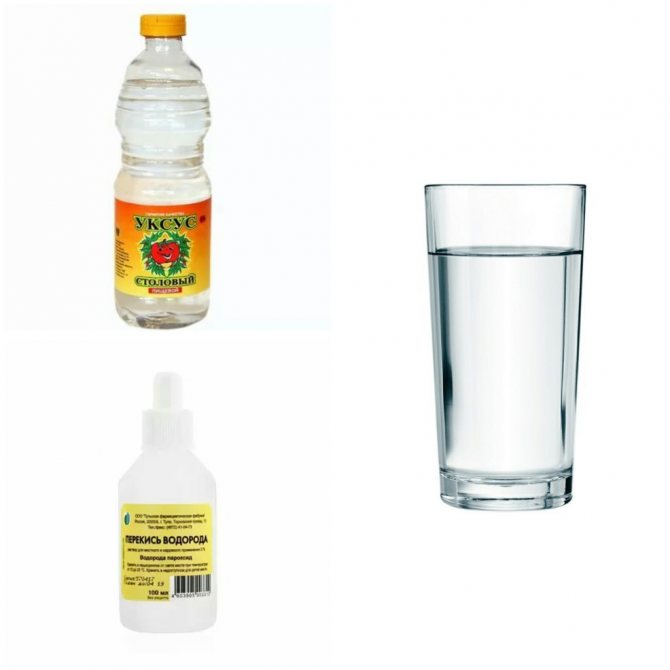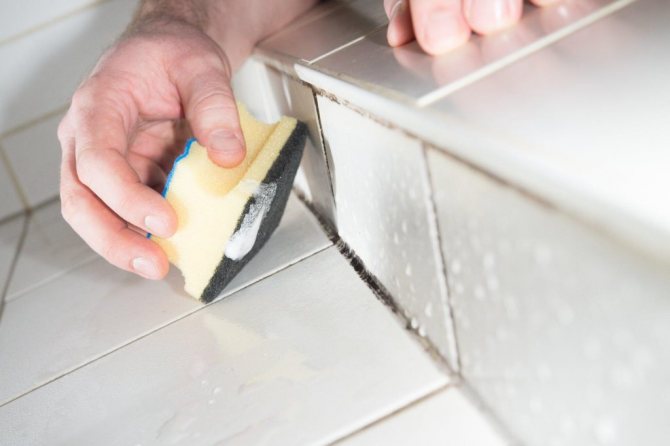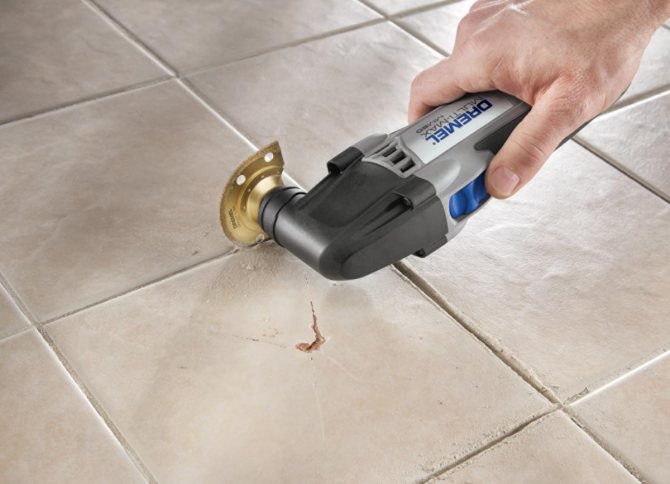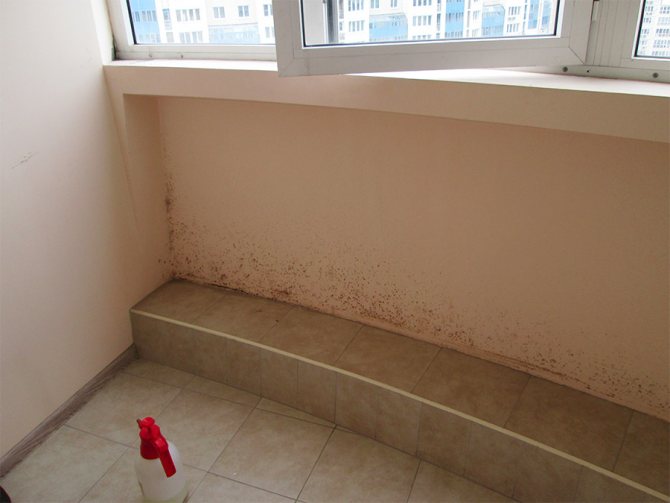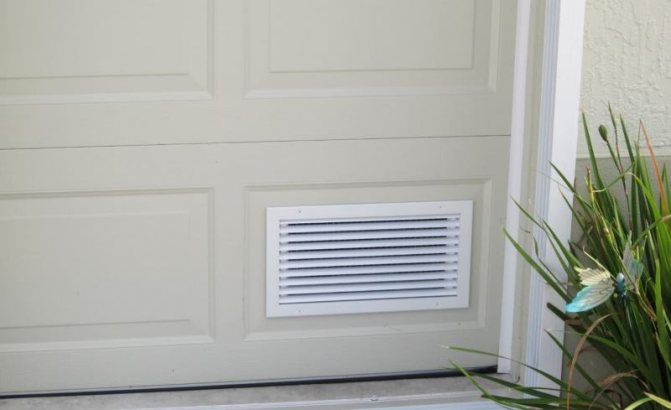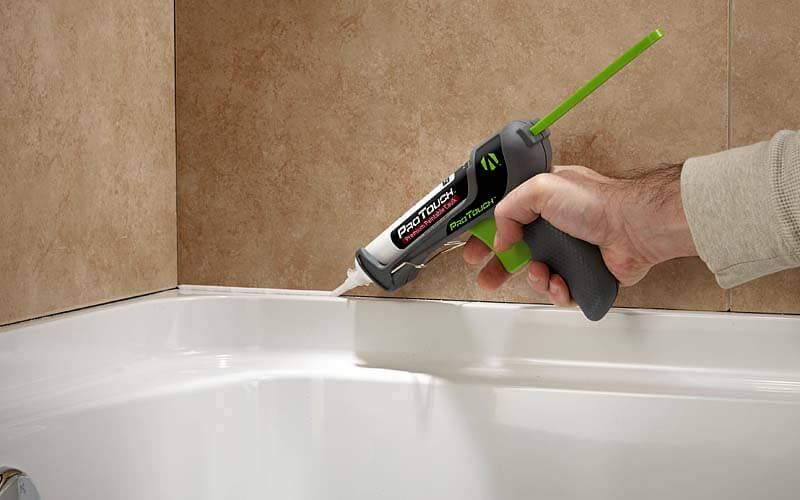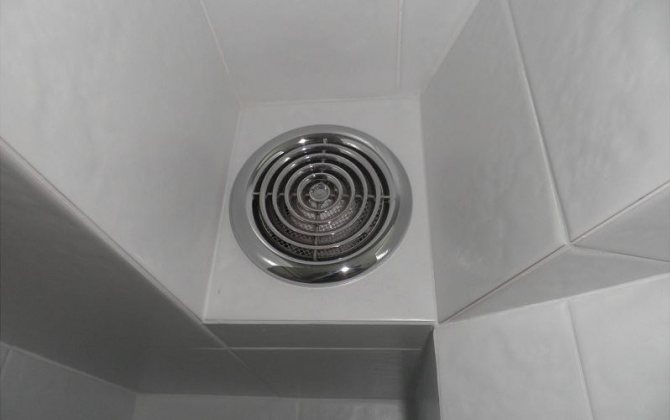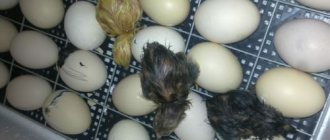Many housewives are wondering how to remove fungus in the bathroom, because mold on the walls is a common occurrence in rooms with high levels of humidity. Such a problem not only spoils the appearance of the bathroom, but also poses a danger to the health of residents, because regular inhalation of fungal spores can cause an allergic reaction or even harm the respiratory system.

There are several effective ways to remove fungus from the bathroom.
Why mold is dangerous for humans
Growing, the fungus in the bathroom leaves a conspicuous black mark on the walls, seams and on the ceiling. In addition, the bathroom fills with a musty smell. Over time, the aggressive effect of the fungus can adversely affect the condition of finishing and building materials, causing their deformation and destruction. This can lead to the need for urgent and costly repairs.


But there is something that “money cannot buy”. This is health.
Fungus and mold spores, dissolved in the air, adversely affect the health of the respiratory system, can lead to allergies and many other diseases. Especially negative is the effect caused by the appearance of fungus in the bathroom on people suffering from asthma, and on young children whose immunity has not yet matured.
Therefore, it is necessary to fight fungus and mold in the bathroom immediately from the very moment of their detection.
The importance of timely elimination of the focus
The fungus is dangerous not only for the surrounding objects. A pathogenic strain may develop, which, when penetrating into the human respiratory system, negatively affects the lungs, mucous membranes, and soft tissues.
This is fraught with the following consequences:
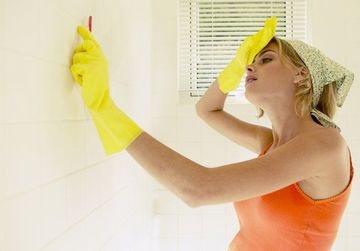

urinary tract infections;- genital candidiasis;
- respiratory diseases (oral candidiasis, tracheitis, bronchitis, fungal pneumonia);
- cutaneous candidiasis;
- fungal conjunctivitis.
The condition is especially dangerous for young children. Under unsanitary conditions, the risk can arise not only for health, but also for life.
Why does mold appear in the bathroom
The reasons that fungus began to develop in the bathroom are as follows:
- The bathroom is not installed or the exhaust ventilation is not working well.
- Bathroom humidity is above 90 percent.
- The pipes in the bathroom are poorly protected from leaks or serve as places for the accumulation of condensate (this is especially typical for pipes made of cast iron, aluminum); their waterproofing is broken.
One of these conditions is enough for the fungus in the bathroom to begin to develop threateningly. You can easily notice how the seams between the tiles are covered with a black coating, and on the walls and on the ceiling, small black dots grow into spots that cause trouble to the eye.
Common types of mold
Almost every housewife had to deal with black spots, which are usually localized in the bathroom or other rooms with high humidity.
This plaque should not be confused with dirt - it is usually caused by certain types of microscopic organisms.
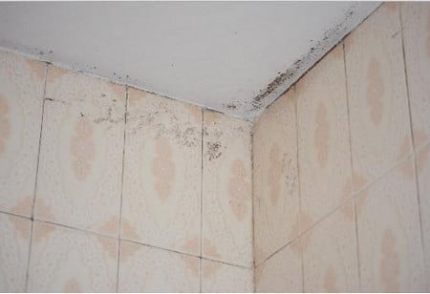

Most often, mold colonies form in the upper part of the walls, from where they spread to the ceiling and vertical surfaces
On the walls, floors and ceilings of rooms, three common types of microflora can parasitize.
Blue fungus. This type of protozoan is able to reproduce only on wood, preferring pine structures.
The blue fungus can be found in baths and saunas built from coniferous trees, but it does not threaten the inhabitants of city apartments.
Rotting bacteria (bacterial, brown, white rot) are also capable of multiplying only on the tree, causing the breakdown of cellulose fibers.
It is extremely difficult to remove these microorganisms by stopping the process of wood destruction. You can only take measures in advance by treating the material with special fungicidal solutions.
Black mold. The greatest danger to people is represented by molds, which form black spots. This group includes several representatives of microflora (Chaetomium, Ulocladium, Aspergillus and others).
Black mold is capable of settling not only on organic surfaces, but also on ceramic tiles, concrete, a layer of paint, and brickwork.
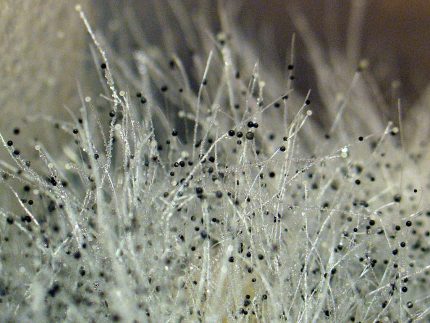

Examining black plaque under a microscope, you can see that it consists of many tiny fungi, the mycelium of which penetrates any surface
Such microflora should not be ignored, it is advisable to take immediate measures to eliminate it.
Pre-treatment of moldy areas
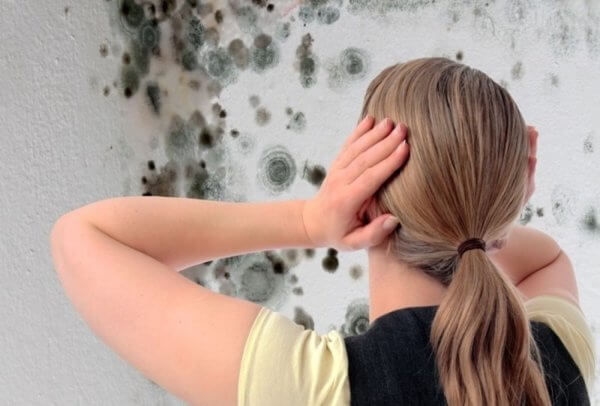

Go through four stages of surface preparation before removing the fungus.
- Treat the surface with a damp soapy sponge, remove the top layer of rot.
- Wipe the moldy area with a dry cloth.
- Dry rot stains with a hot air gun.
- The treatment will be successful if the air in the bathroom is dry and the water is turned off.
Mold is dangerous if it gets into the respiratory tract or on the skin, causing undesirable effects on human health. Before starting work on removing fungus from walls, tiles and ceilings, do not forget to take precautions by wearing a respirator and rubber gloves.
If the fungus has damaged the plaster on the wall, it is advisable to remove the areas of the material damaged by mold. It is better to clean a layer of plaster from the wall or ceiling with a spatula.
Industrial products for the fight against fungus
In specialized stores, you can find various preparations for combating household fungus in the bathroom:
- "Antifungal" is a special solution with a broad fungicidal effect. The components of this liquid mixture are active against mold, mildew, mosses, lichens and some types of bugs that can grow in the apartment. The product is suitable for all surfaces except metal and propylene. "Antifungal" can be added to water-based paints, plaster, grout, as well as used alone for surface treatment.
- "S-Hydrotex-P" is a domestic dry mix that can be put in any room: from bathroom and kitchen to living rooms. The mixture is applied to reinforced concrete structures, which allows you to effectively fight not only the effects of black mold, but also to destroy its foci.
- Natura Antimantar is a special water-based primer for walls and ceilings. It is applied in a thin layer to the affected surface, completely destroying the fungus. Once dry, the primer forms a protective film that prevents mold from reoccurring. Additional advantages of this product are that it does not have a specific smell.
- "Biolavatio" - used in rooms with a lot of mold and mildew. Not only destroys harmful microorganisms, but also whitens mold-darkened surfaces.
- Homeenpoiste is a chlorine-based antifungal agent.Fights fungus spores on all surfaces, including wood and plastic.
- "HG" is an antiseptic that is produced in the Netherlands. Effective for the destruction of fungal infection in rooms with high humidity. It can be used for the treatment of ceramic tiles, tile joints, walls and ceilings in the bathroom. "
- Renogal is a German sanitizing solution that fights not only the fungus, but also other pathogenic microorganisms that can settle on various surfaces in living quarters.
When using industrial anti-fungal agents, you must strictly follow the instructions for use and observe safety precautions so that strong chemical components do not damage the skin of the hands, and vapors of toxic substances do not enter the respiratory tract.
How to use mold antiseptics


When purchasing professional anti-fungus formulations, make sure they are designed to eliminate mold, not prevent it from growing. Read the label carefully or consult your dealer. Follow the manufacturer's instructions for the tool.
Among the special agents against the fungus are the following:
- "Milkill" - does not pose a danger to human health and allows the processing of surfaces with a very fine porous structure.
- "Antifungal" is an excellent remedy against fungus and mold, allowing to remove fungus on the walls of any structure and origin.
- "Hydrotex", "Isocid" - created specifically for antifungal treatment of rooms that are constantly exposed to high humidity.
Means for sanitation, ionization
Such formulations have the following advantages:
- remove pathogenic microorganisms even in the air;
- penetrate into all parts of the room;
- quickly destroy injections, reduce the risk of human infection;
- long-term action (if used correctly, mold does not appear for a long time);
- no need for re-processing.
The method also has disadvantages:
- high price:
- the risk of human intoxication;
- the need to call a specialist for processing or preliminary training.
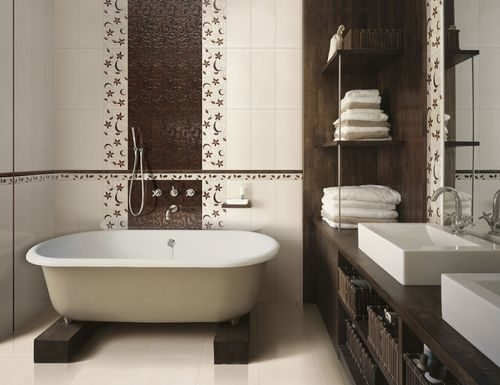

The fungus spreads not only in the focus of education, but also in various parts of the room, in the air. It is worth using special means for sanitation and ionization.
How to treat a bath if the fungus has just appeared
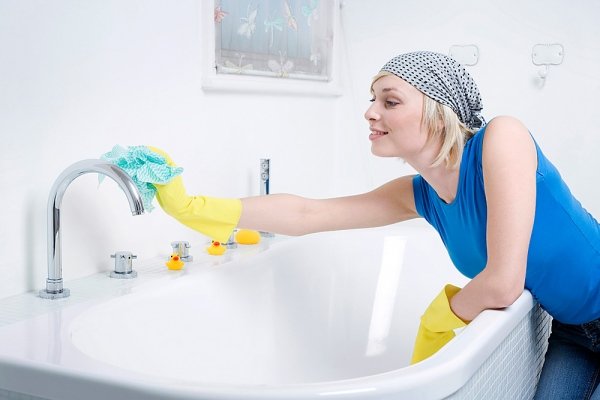

Provided that the defeat of the bathroom fungus has not reached alarming proportions, you can use folk remedies, among which the most common are:
- Vinegar. It is applied to the affected surface with a sponge or spray. After processing, allow to dry, then brush off mold residues and rinse with water.
- Camphor balls. They are laid out in different corners of the bathroom, the effect of them is noticeable only at the initial stage of the development of the fungus.
- Soda and vinegar. Apply a thick layer of baking soda to the area affected by the fungus. Then vinegar is applied to it. When the foam has settled, the surface is cleaned with warm soapy water.
Mechanical cleaning methods
Mechanical methods are used if the joints between the tiles have turned black for a long time. Chemicals fail to remove stubborn contaminants. In some cases, the grout has to be removed.
Sandpaper
This tool helps to remove thin deposits from seams. Contaminated areas are treated with bent sandpaper. After that, the tile is wiped with a clean cloth.
Processing is carried out carefully, trying not to damage the tile. After cleaning, the grout can be painted over
Sandpaper for cleaning tile joints.
Steam cleaner
A steam cleaner is an apparatus that delivers a jet of steam under pressure.The use of the equipment helps to quickly scrub tile joints at home, remove mold and bacteria. To remove dirt residues after treatment, the surface is wiped with a wet cloth.


Hard sponge
Using this tool is an effective and inexpensive method for removing black plaque. The seams are cleaned with a hard sponge, after which the tiles are wiped with a clean cloth.
This method does not provide disinfection, therefore it is used in combination with chemical compounds.
Melamine sponge
Melamine sponge removes dirt of any origin. It functions like a simple eraser. The tool copes well with lime deposits, rust, mold. To eliminate pathogenic microorganisms, the sponge is used in combination with chemicals.
Melamine sponge for cleaning seams.
Bleach or whiteness will remove fungus in the bathroom
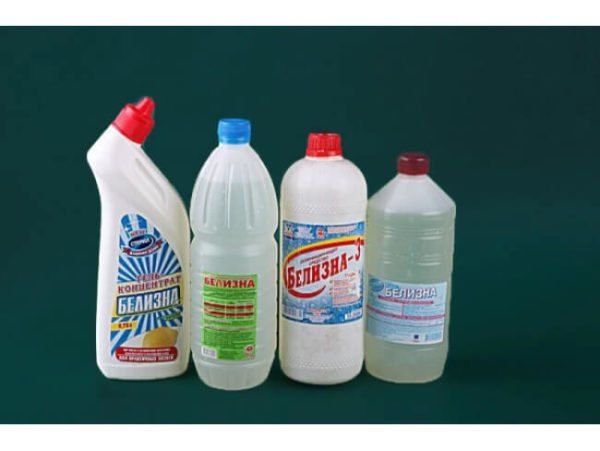

Remove fungus from the ceiling and walls with bleach. Don't forget about gloves and a respirator.
- Add 1:10 bleach to the water.
- Spread the resulting solution with a sponge or spray.
- Do not rinse off the bleach; it will prevent rot from reoccurring.
- Ventilate the bathroom.
Folk recipes
How to remove mold in the bathroom on your own? There are probably substances in the medicine cabinet or in the kitchen that can effectively fight the fungus. Many of them are well known to us.
Using them for cleaning, you can not only achieve perfect cleanliness in the room, but also defeat the fungus for a long time.
Soda is the safest homemade way!
The instruction is as follows:
- To prepare the solution, take 1 tsp. soda for 1 tbsp. water.
- The resulting product is used to wipe the spots with spots.
- You do not need to wash off the product.
This method is absolutely safe for people and animals. The solution does not have a strong odor.
Vinegar


You can apply this product with a moistened washcloth or with a spray bottle. After an hour, the surface is washed with water, and the room is well ventilated.
To remove mold with vinegar, you will need to do a few weekly treatments. Work better with gloves.
The disadvantage of this method of removing the fungus is the pungent smell of vinegar.
Hydrogen peroxide
This product has a whitening effect, therefore it is suitable only for light surfaces:
- Before processing, the walls must be cleaned of visible fungus.
- Peroxide is applied with a sponge to the prepared surface.
- The product does not need to be washed off.
Ammonia
This method is great for removing black spots. from tiles, mirrors, shower walls and other smooth surfaces:
- Apply diluted ammonia.
- It is mixed with water in a 1: 1 ratio.
- The solution is sprayed with a spray bottle, left on surfaces infected with fungus for 60 minutes and washed off with water.
The disadvantage of this method is the pungent smell of ammonia, which can cause a headache.
Bura
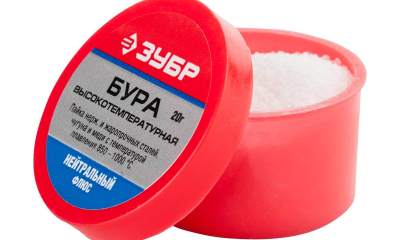

It is one of the safest and most effective antifungal drugs available.
To clean the walls:
- A glass of borax is diluted in 2.5 liters of water.
- With a brush, the solution is applied to all contaminated surfaces in the bathroom.
- You do not need to wash off the product. It will serve as a good protection against further mold growth.
Tea tree oil, lavender, grapefruit seed, rosemary
Each of these oils is a natural antiseptic:
- Tea tree oil... To achieve the desired effect, a teaspoon of tea tree oil is diluted in a glass of water. The product is sprayed onto all surfaces and is not washed off.
- Lavender oil is mixed with water in a different proportion... You only need 10 drops of lavender oil for 1 glass of water. Apply and do not rinse.
- Other oils... A working solution is prepared from rosemary oil or grapefruit seed oil according to the recipe above and applied to the affected areas.
This method will not work for people who are allergic to these essential oils.
Potassium permanganate


Potassium permanganate will easily cope with the fungus on the walls. A solution of a teaspoon of potassium permanganate and 1 liter of water will have a deep pink color, so it will not work on all surfaces.
The advantages of this tool include:
- lack of a pungent odor;
- ease of use.
It is not necessary to wash off the solution from the surfaces.
Lemon acid
The recipe is simple:
- A teaspoon of citric acid or freshly squeezed lemon juice is added to a glass of water.
- Apply to all surfaces with and near the fungus.
- The product is not washed off.
The acid will keep the fungus from spreading. This product will perfectly clean the tiles and give them a shine.
A mixture of water, peroxide, vinegar and boric acid
Each component of this product can easily cope with mold, and together they will give an unsurpassed result on all types of surfaces.
To obtain a working solution, take:
- 4 tablespoons of water;
- 2 tablespoons of peroxide;
- 2 tablespoons of vinegar;
- 1 tablespoon of boric acid.
The mixture is sprayed onto a mold-infected surface.
We remove mold in the bathroom with a mixture of vinegar, peroxide, boric acid and water:
Soda with vinegar
If you rub the surface with baking soda and then sprinkle with vinegar, then this will help remove mold and lighten stains from it:
- First, rub the baking soda vigorously on the infected areas.
- Then sprinkle with vinegar.
- After 40 minutes - an hour, wash off with water.
- We repeat in 1-2 days.
Removing fungus from joints and tiles
The fungus formed at the seams between the tiles is more difficult to remove than on the tiles. Stock up on baking soda, vinegar, a toothbrush, a fine brush, and patience.
- Pour vinegar into an enamel bowl.
- Use a thin brush to spread vinegar on the joints between the tiles.
- After ten minutes, it is recommended to rub all seams with the hard side of a sponge and rinse off the remaining vinegar with water.
- Dip a damp toothbrush in baking soda.
- Clean the joints between the tiles with baking soda, rinse off the remaining baking soda with water, wipe the tiles thoroughly.
- It is advisable to coat the tile seams with a new grout.
Consequences of infection with pathogenic flora
Most of us do not understand the magnitude of this common problem. Often, housewives simply wipe black smudges from surfaces during the current or general cleaning, giving little thought to the harmful effects of dampness in the bathroom.
First, together with mold, which is a colony of a single-celled fungus, a fungus appears - a more complex system of organisms. Fungal spores can be present everywhere, but they reproduce only in a humid environment.
Secondly, the thriving life of the fungus can cause a number of serious difficulties, the most innocent of which can be the eerie smell from the bath accessories.
Here are some of the effects of bacterial bathroom contamination:
- rapid destruction of building materials. Black or white fungus is capable of corroding any building texture to the ground within 1-2 years. If we do not take action, we will do major repairs every year;
- spores in the air will definitely move to other rooms and, upon finding damp places, will begin to multiply there;
- pathogenic flora freely enters the respiratory tract of a person, causing allergic bronchitis and sinusitis, asthma, severe lung lesions that are difficult to diagnose;
- the use of bath accessories affected by microbial spores causes thrush, stomatitis, streptoderma, allergic dermatitis, mycoses of feet and nails;
- constant inhalation of waste products and vital activity of bacteria affects the human gastrointestinal tract, causes dysbiosis, diarrhea, vomiting, and weaken the immune system.
After a while, fluffy streaks and black stripes between the cladding panels on the sealant, to our chagrin, will reappear. Here is a list of common causes of mold infection in the bathroom.
- Incorrectly installed ventilation or heating system. A well-heated room and moisture retention are the prerequisites for the cultivation of harmful microflora.
- Lack of natural sunlight, as UV rays are detrimental to the life of fungi.
- Poor sealing of interpanel seams. If the sealant is damaged, the displacement of the "dew point" in the walls due to temperature changes causes condensation, which constantly moisturizes the surfaces.
- Damaged drainage system. A constantly and imperceptibly leaking mixer or pipe under the bathroom are possible sources of dampness; the fungus is not removed until the emergency site is localized.
- Insufficient cleaning after bath procedures. Vapors and drops of moisture on the walls, sealant between tiles and polymer panels must be thoroughly wiped off after taking a shower.
- Drying used wet towels in the bathroom. The fungus simply loves such epicenters of dampness. Wet laundry should only be dried outdoors.
Creosote will remove the stubborn mold
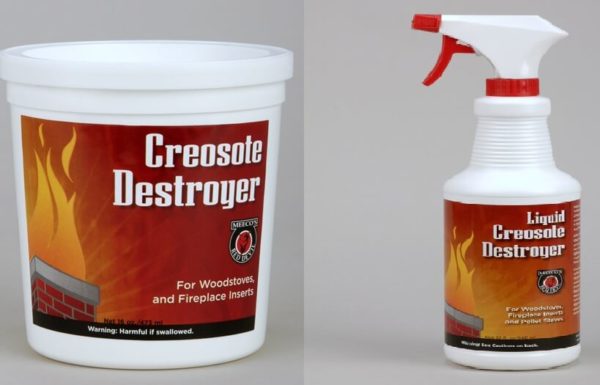

It is possible to destroy even ingrown mold with creosote, but remember that the agent is aggressive and will ruin the wooden surface. Wear a respirator and rubber gloves. Fighting moldy fungi in this way is hazardous to health.
- Dissolve the creosote in oil or alcohol.
- Apply to mold-damaged tiles and seams.
- It is better to remove the remaining yellowish mass.
Fungus prevention
Despite the fact that we have figured out how to remove fungus and how to remove black mold in the bathroom, I want to face this problem as little as possible, or even not know about it at all. After all, getting rid of such a disadvantage is still a tedious process. So it is better to prevent than to cure. And this is not difficult.
Keep simple regulations:
- Monitor the state of communications, eliminate all leaks.
- After bath procedures, wipe the walls and plumbing from condensation dry.
- Leave the bathroom door open as often as possible. Especially after taking a shower or bath.
- Once a month, treat all surfaces in damp rooms with any anti-mold product. Instead, opt for non-toxic substances such as baking soda, vinegar, or essential oils.
- Provide a proper ventilation system in the bathroom.


Mold is dangerous to health, it must be removed at the first manifestations, even before blackness begins to grow over all surfaces, and a musty smell creeps through the apartment. If laundry detergent and gels don't fight effectively, take advantage of our tips. There are quite a few remedies for mold. Choose at your own discretion and depending on the situation. Photos and videos illustrate that you can defeat the enemy. Most importantly, remember that mold removal is not done quickly, all procedures must be repeated several times with an interval of a couple of days for greater efficiency. Comfort in your house. And be healthy!
Brown processing
Use sodium tetraborate or borax to treat moldy areas in the bathroom.
- Dissolve one glass of borax in two and a half liters of water.
- Use an old brush to clean the moldy areas in the tub with the solution.
- Collect the remains of sodium tetraborate with a cloth.
- It is not recommended to wash off the borax, but it is better to treat the surface with a dry cloth in order to remove moisture.


The main thing about the problem
Scientists have found that mold appeared about 200 million years ago. The fungus survived the drought and ice age. Mold traces are found even in areas with high radiation background, where other organisms cannot survive.
The causes of mold
There are several reasons why mold can appear in the bathroom. The main ones are:
- High humidity level. The bathroom contains water pipes, a sink, a bathtub, a washing machine and other items related to moisture. Therefore, the humidity is constantly increased here.Such an environment creates favorable conditions for the reproduction and formation of fungal organisms.
- The predominance of artificial lighting. Most often, modern bathrooms do not have windows, so the light in them is supported by artificial light.
Experts have long proven that natural light suppresses the viability of the fungus, therefore, its absence provokes the growth of mold. - Heat. Hot water is constantly used in this room. In addition, a dryer can be installed in it. Elevated air temperatures are optimal conditions for fungal life forms.
- Cracks, cracks, chips. In the bathroom, you can find many gaps, inside of which moisture accumulates. In most cases, moldy marks appear under the bathtub, PVC panels, tile seams, or behind a washing machine.
- Air congestion. Lack of window openings and insufficiently efficient ventilation are additional factors contributing to the development of mold.
Signs of the appearance of a fungus


Mold can be recognized by the following signs, depending on its type:
- gray and black: dark spots on the surface, in the early stages the mold is colorless, so it is difficult to notice;
- white: a whitish coating with a velvety and fibrous texture;
- green and blue: tracks have a heterogeneous structure;
- red or pink: fluffy surface, light matte (soapy) coating.
Locations of mold stains
Mold spots can occur in different areas. Depending on the variety, mold can be localized in the following places:
- gray and black: rooms with high humidity;
- white: nutritious foods, moist coatings, potting soil for indoor plants;
- green and blue: natural finishing materials (including wood), soil for plants, food, bricks;
- red or pink: rotting products, some types of houseplants.
What harm can mold do?


Mold can cause significant damage to the finish by eroding materials. In addition, her spores can have an adverse effect on the human body. Fungus can cause the following problems:
- rashes on the skin;
- cough;
- feeling lethargic and weak;
- chronic rhinitis;
- baldness;
- eczema;
- bronchial asthma;
- severe intoxication;
- rheumatic painful sensations;
- deterioration of the digestive system;
- chronic headache;
- conjunctivitis;
- hemorrhages of internal organs.
Removing mold from the sealant
An annoying mold lives even on the sealant. Therefore, it is desirable to use a sealant with the addition of fungicidal components against the fungus. We will learn how to remove mold in the bathroom with silicone sealant and clean the seams with our own hands.
- Cut off the sealant with a knife. Make cuts in the sealant and, picking up the silicone mass, pull the tiles out of the seam. Remove mold by cleaning the seams thoroughly.
- Remove mold on the sealant with a cleaning agent and bleach. Dilute the bath cleaner in a container of water and stir. Use a sponge soaked in the solution to clean the affected areas. Thoroughly rinse away any remaining mold and cleaning agent. Take the bleach and spread it over the sealant. After twenty minutes, scrub the surface with a brush. Rinse with clean water and dry the sealant with a dry cloth.
- Use isopropyl alcohol to prevent the fungus from reoccurring. Pour alcohol between the tiles and wait half an hour. Blot any remaining alcohol with a rag and leave overnight. After the joints have dried, you need to re-treat the cleaned places using a new sealant. You can use the bathroom no earlier than in a day.
Replacing grout
Sometimes it is not possible to clean the mold with these products. Then you will have to make repairs, of course, you will not need to completely change the tiled coating, but you will have to redo the seams.
How to do:
- if mold spots appear on the sealant and cannot be removed with special means, then they should be redone. First of all, we clean the mixture with a nail, spatula or other device;
- then you need to purchase a lubricant for seams with an anti-fungal and moisture-resistant effect. It is desirable that it be on the sealant. The sealant does not allow moisture to pass through;
- the mixture is applied to the intervals of the tile covering with a rubber spatula.
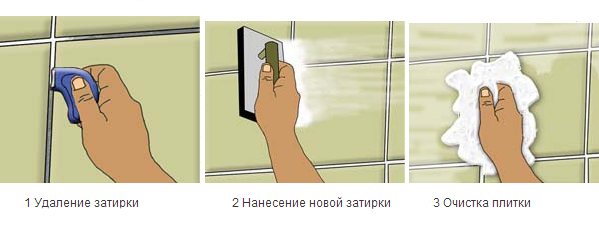

Sequence of actions when replacing grout
Fungus in the bathroom on the ceiling: methods of getting rid
When a fungus appears in the bathroom on the ceiling, there are only two ways to deal with it. A radical way that requires capital investment. It includes the following steps:
- With the help of a spatula, all old whitewash and plaster is removed from the affected surface of the ceiling, so that the floor slabs become visible.
- Prime the surface with a special antiseptic compound. It is recommended to use a brush in order to properly process the grooves and seams on the ceiling.
- Then work is carried out on the plaster, putty and re-primer on the ceiling.
- After that, the surface of the ceiling must be sanded and painted.
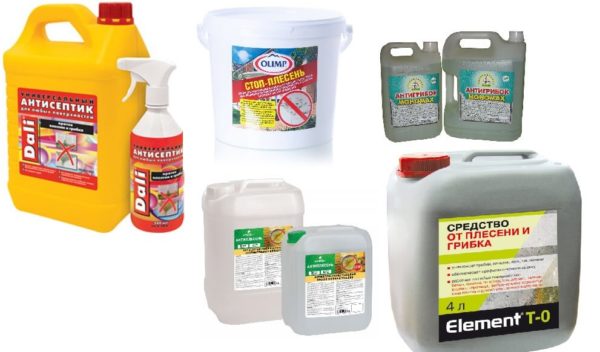

Receptions on different surfaces
There are surfaces that require a special approach and attention.
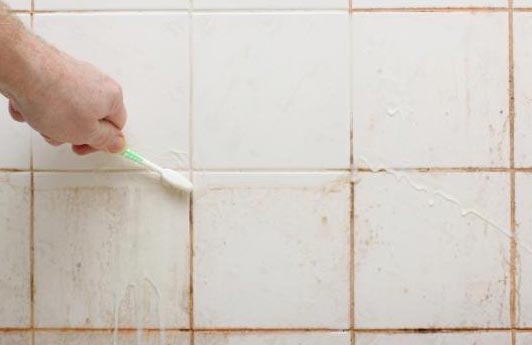

Tile joints
If the fungus appears at the joints of the tiles, then you can use the following instructions to remove it:
- First, you need to identify the area of mold localization. At the same time, it is recommended to mark the most extensive foci with a bright felt-tip pen so as not to miss them during processing.
- Use a wire brush or sandpaper to remove the dark grout. It is advisable to additionally remove the coating near the moldy marks, because it may contain fungal spores.
- Apply whiteness to clean areas and heat the surface with a hair dryer or soldering iron.
- Then it is necessary to make a trowel mixture and process the necessary areas. After the composition has dried, remove the excess with a sponge.
- At the final stage, it is necessary to process the inter-tile space with a transparent varnish composition.
We also recommend looking at - How to update the joints between tiles in the bathroom
Tile
To process the tile, you need to dilute 1 tbsp. l. tea tree extract in 0.5 l of pure water. The prepared mixture should be placed in a spray bottle and shake the bottle.
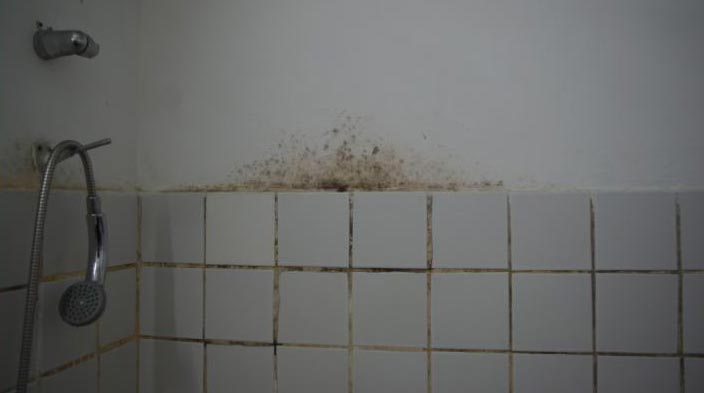

The solution should be sprayed onto the tile and left for 5-6 hours. Then wipe the surface with a cloth.
The tea tree extract is not only an effective antiseptic, but also an allergenic substance. Therefore, before using it, you should find out how other family members will react to it.
Sealant
If mold appears on a silicone-based sealant, you can use a mixture of 1 part boric acid, 2 parts hydrogen peroxide and 4 parts vinegar.
In the finished solution, you need to wet the sponge and treat the surface. After 20-30 minutes, the composition must be washed off and wiped off the moisture from the sealant.
After such treatment, the room must be ventilated for 5-6 hours.
Ceiling
It is extremely difficult to eliminate fungus on such a surface. In addition, mold can penetrate the concrete through paint and whitewash.
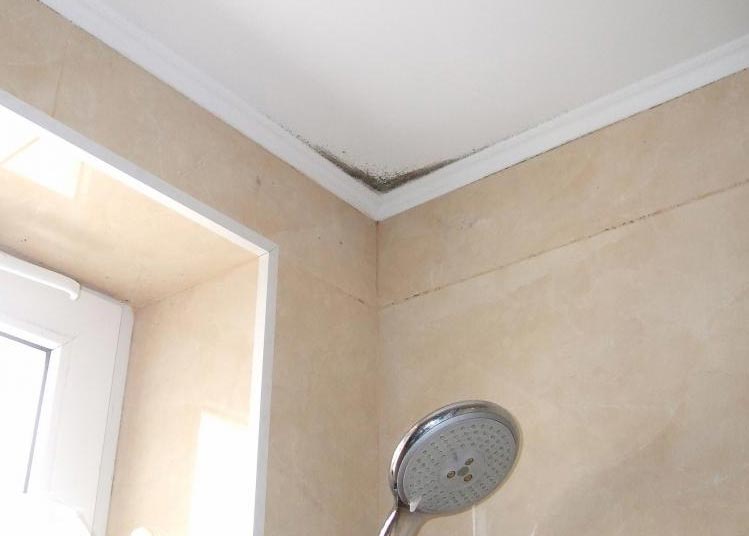

In this case, repair experts recommend using special impregnation antiseptics, which are sold in home improvement stores.
Before applying the solution, you need to treat the ceiling surface with warm water from a spray bottle. This is to prevent mold from spreading throughout the space.
The product is sprayed onto previously cleaned areas and 50-60 beyond. After the coating is dry, the antiseptic compound should be re-sprayed.Then the surface is cleaned with a metal scraper or a brush with hard fibers.
To achieve the maximum effect, it is recommended to repeat the treatment 2-3 times. At the final stage, the ceiling must be putty again and the necessary finishing work must be done.
How to deal with mold on the curtain
Many housewives are unaware of the existence of harmful fungi on the curtain in the bathroom. Unlike fungus on the walls, mold on a dark curtain is not visible, therefore, the more often you wash the curtain, the higher the chances of avoiding the growth of fungi.
- You can fight moldy fungi that attacked the curtain with whiteness.
- Apply Whiteness to moldy spots with a colorless sponge and wait a couple of minutes.
- When the mold disappears, it is better to rinse the curtain under running water to wash off the Whiteness.
- Further, it is worth washing the curtain in the washing machine or with your hands with powder.
- You can use chlorine bleach to clean the curtain from mold. Be careful and read the instructions for use carefully. Bleach can not only remove fungal contamination, but also spoil the color of the curtain.
Methods for cleaning seams
The first way... Simple and fast. For him, take ordinary soda and bleach or vinegar solution. To do this, a liquid solution of bleach is passed along all the seams between the tiles, where there is blackness. Next, wipe the previously treated areas with a cloth (sponge), the composition must be completely washed off the walls. Fix the result by going through the same places with soda.


Second way... Sodium bicarbonate (ordinary soda) is taken and poured onto a flat dish. Taking a toothbrush, soak the bristles and dipped in soda powder. Next, a brush with soda is used to wipe the inter-tile gaps. Then the treated seams are rinsed with water and wiped dry.
The first two methods really help to get rid of blackness. Six months - that's how long their shelf life can be. Therefore, a repeated fungal infection of tiled surfaces in the bathroom is not excluded. Those who do not intend to experiment with different methods for too long may choose more effective measures.
Third way... Instrumental, involving the use of a hand-held device - a screwdriver. Taking it in hand, they try to remove the entire layer of grout from the seams cleanly. Yes, the procedure is not easy. However, it is also the most effective one, allowing you to eliminate mold on the grout without dismantling the tile. It is possible to remove both the mold and its source mechanically with a little effort. The method is traumatic. In addition, damage can be done to tiles. After opening the cracks, they are treated with vinegar, and after that they are again covered with a sealing fugue. In this case, the grout must be selected one that includes both moisture-repellent and antiseptic substances.
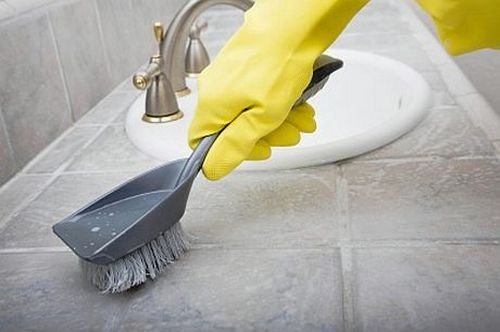

How to avoid mold in the bathroom


- To protect the bathroom from fungal growth, reduce the humidity level to 30%. A heated towel rail will become an assistant.
- Ventilate the room. If the ventilation in the bathroom does its job poorly, then you need to find the reason. It may be necessary to clean the accumulated debris from the ventilation ducts. When choosing a new fan, you should pay attention to its power, it should be sufficient to create comfortable conditions in the bathroom.
- When a family member has taken a shower, do not close the door, let the moisture evaporate.
- Work to protect the bathroom from moisture is reduced to painting or replacing old pipes (it is recommended to use plastic or metal-plastic pipes). The bathroom door also needs to be painted with a special water-repellent paint or changed to a new one with a waterproof coating. Before laying the tiles in the bathroom, treat the walls with antifungal agents that help fight mold.
- Make sure that your plumbing does not leak.All pipes in the bathroom are carefully checked for leaks and condensation. It is worth paying attention to the drainage system of the washing machine, as well as to the condition of the mixer, shower and other plumbing elements. After carrying out water procedures, prevent the accumulation of moisture, wipe the walls of the bathroom dry and ventilate the room well.
- Seal joints exposed to moisture.
- Do not use the bathroom to dry your laundry.
- Check the condition of the furniture. If there is furniture in the bathroom affected by the fungus, you should get rid of it. The fact is that mold spores that have settled in the pores of furniture are difficult to remove and can multiply quickly in favorable conditions.
- Work on the destruction of the fungus. This is the most time consuming and painstaking step in the fight against mold in the bathroom. Before starting work, it is necessary to dry the surfaces affected by the fungus in the bathroom with a building hairdryer or using a powerful heater. After that, it is necessary to treat the surfaces affected by mold with the help of special chemical or folk remedies. Mold that has settled on the seams between tiles or tiles is necessarydremove completely with a scraper or spatula.
Knowing how to wash the mold in the bathroom, you will, with some effort, defeat a dangerous enemy, but it is better to prevent the appearance of the fungus. Follow the simple rules for taking care of the bathroom and you will protect your family from possible diseases.
Locations of mold stains
We sort of figured out the reasons, now it's worth finding out where spots of black or green fungus can appear. This will simplify the work and also save processing costs.
In the bathroom, fungal accumulations often appear in places:
- spots of black or green color often fill the seams of the tile covering;
- fungus can appear in the corners of the room;
- at the joints of the walls;
- sometimes mold can be found in the shower stall, between the shelves, in any spaces of cabinets, walls.
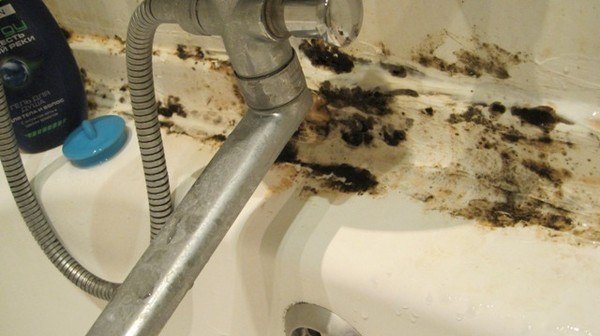

Mold in the area of the mixer
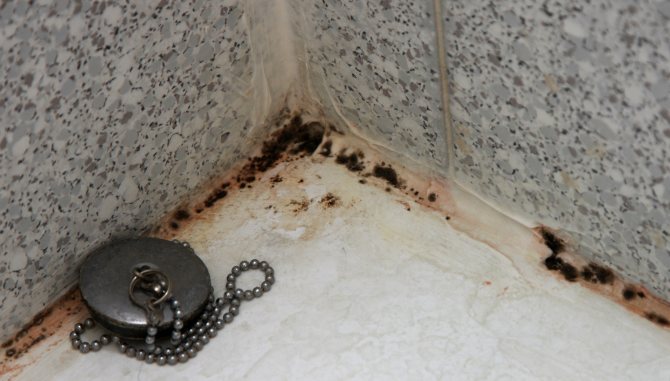

Mold in the corner of the room
Mostly fungal spots appear in places with an increased accumulation of moisture. Be sure to wipe everything thoroughly during the cleaning process and check for mold spots.

